
Creative Team Gets Back to Basics, with a Few Creative Twists
The Foo Fighters had wheels in motion to go out in 2020 on what was going to be a spectacular series of concerts celebrating their 25 years together. “That was going to be a lot of fun, with great automation, a revolving stage, and include them driving up in the van they took out on their first tour in 1995,” says production/lighting designer Dan Hadley. He had ordered 52 PRG Toblerone for eye candy and I-Mag support… and then his first inkling of trouble came when he got word that the factory making them had shut down.
So this, the band’s 2021 trek, is not that tour. No pyro, no lasers, no automation. “It’s not spectacular, but it’s real,” Hadley continues. “But creativity is the product of limitations. You are forced to come up with more imaginative things in situations like this.” Extraordinarily creative use of video added to the kinetic energy of the band, building on that energy rather than distracting from it. Yet in the end, “creativity didn’t play as much as a part in this design as flexibility did. Bookings have been a moving target, and I needed to make sure that we’d be able to have something that would be replicable off the shelf wherever we were going next, sometimes with very little notice and long distances in between shows. This is one reason we focused resources on what goes on an upstage screen, as that’s omnipresent for live shows today.”

“Where Rock ‘n’ Roll Began”
Hadley grew up on rock ‘n’ roll, loving everything about it. He played drums in an alt rock band where he handled all the gear. Meanwhile, he got a gig working the stage at the local Six Flags (Magic Mountain near Santa Clarita, CA). In the you-can’t-make-this-up category, the first concert he ever worked was for Chuck Berry. Berry, notoriously cheap, traveled with no band, let alone a crew. During a duck walk in the show he slipped and damaged his Gibson guitar. He handed it to the Six Flag’s crew, and suddenly the teen-aged Hadley was trying to pull the guitar jack out from inside the guitar as Berry just riffed poetry. Hadley never did get it working, but another stagehand ran backstage and nabbed a cover band’s white Kramer, and Berry finished up the set with that.
None of that part mattered though. “My first concert began where rock ‘n’ roll began.” He dabbled in audio at the park, but his interest was drawn to whatever the people climbing on those trusses were doing. When he learned that there was an actual career that combined his three loves — music, technical theater and travel — it was game on.
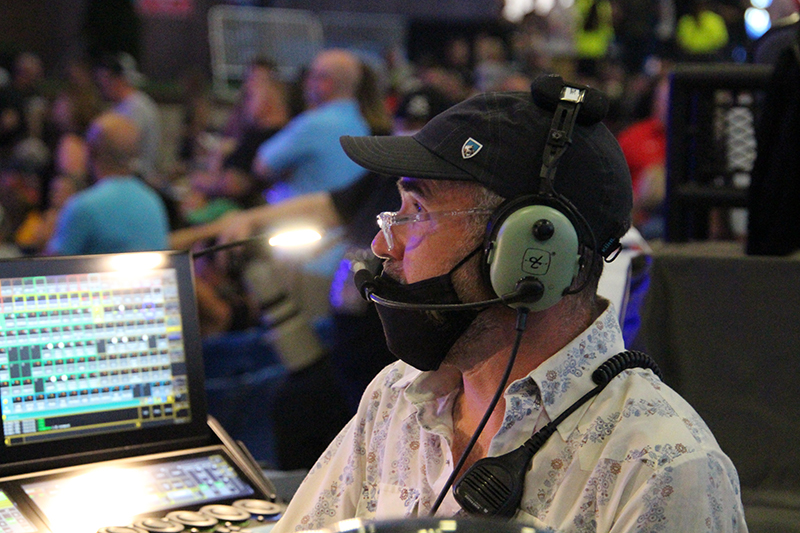
He moved to Salt Lake City, got a job at Oasis Stage Werks, then moved onto Ed & Ted’s Excellent Lighting. In 1998 he toured with Alanis Morissette as low man on the lighting crew. From there it was work with the Brian Setzer Orchestra, Weezer, Queens of the Stone Age, Tenacious D, The Mars Volta, Jack White, Pharrell Williams and Sonic Youth, among others. He first went out with Foo Fighters in 2001, filling in occasionally over the next decade, and has been full time with them since 2011. He’s “always wearing multiple hats,” but for the sake of this article, let’s just say he’s in charge of everything seen by the audience, and he still programs all the shows and “pushes all the buttons.”
The band trusts Hadley completely, and he’s clearly earned the long leash. For this tour, the directive was fewer everything (trucks, buses and crew) for both health and safety and budgetary reasons. “The flown rig is semi-generic, with straight trusses loaded with washes and spots,” Hadley says.
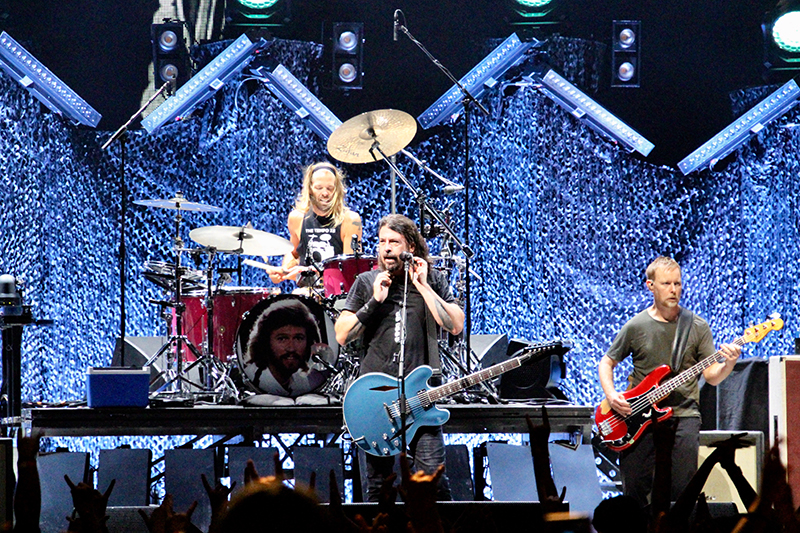
There are the special touches. Hadley had a black camo net custom built from Sew What? that is 48 feet wide and 10 feet tall, broken into nine sections hung in front of a rolling truss tower. “Each tower then moves onto the stage in a changeover, and we just pull the swags across to connect it into one solid drop,” he explains. It gave the background a nice texture and worked to stop the I-Mag wall from being in the background of all the camera shots, “which I find annoying.” He also wanted something solid to put in front of the drum riser and turned to those previous elusive PRG Toblerone for that. “They are interesting in that there is little you see that isn’t the fixture. It doesn’t have a big yoke or big base, and they are able to emit light, reflect it, or simply blend into the upstage video wall. They are quite flexible.” He adds with a chuckle: “Only 12 got made, and I’m only using nine, so we have three to spare!”
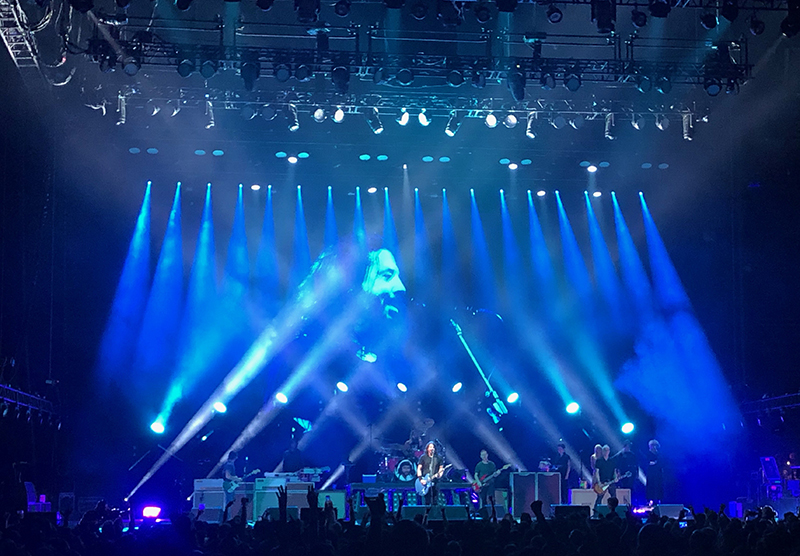
Coming out of Covid, he says they weren’t going to ask a vendor to make a big investment. “This was our time to be creative with the standard rock ‘n’ roll fixtures. For the floor package, we brought out 18 [GLP] X4 Bar 20’s, which you can’t seem to do a show without anymore. They are rightly ubiquitous.” Ten Elation Cuepix WW2s, 11 GLP JDC1s, 10 Robe MegaPointes, nine Martin MAC Quantum Washes and two of MDG’s theONE hazer/foggers were the tools at hand as well. Oh, and a mirror ball. “Got a late request from the boss to put a three-foot mirror ball on for their ‘Dee Gees’ tune [“You Should Be Dancing”]. It’s funny because you think it’s a simple request — ‘there was one at my lame wedding.’ And when you have three trucks, you can’t say no to a mirror ball.” But it is hard to hide, so he consulted with crew chief Jerry “Hodgie” Vierna about the best way to do it. “We essentially built a black drape tube on the truss that it hangs from and it sucks back up nicely when the ‘Dee Gees’ are finished. There is unlikely to be any piece of technology that ever eclipses the elegantly simple impact of a mirror ball.”
While understandably pleased with the look of the whole show, he has a few moments he especially likes. The band dusted off mid-tempo quieter song, “Aurora.” “It’s an old one I’ve only seen them play live four times prior to this, and it’s a pretty, meandering song that looks and sounds great in this show.” It’s an emotional song for Hadley now, because it reminds him of longtime stage manager Andy Pollard, who was scheduled to work for the tour’s opening show at Madison Square Garden on June 20 — but died suddenly June 18. “That song makes me think of him every night.”
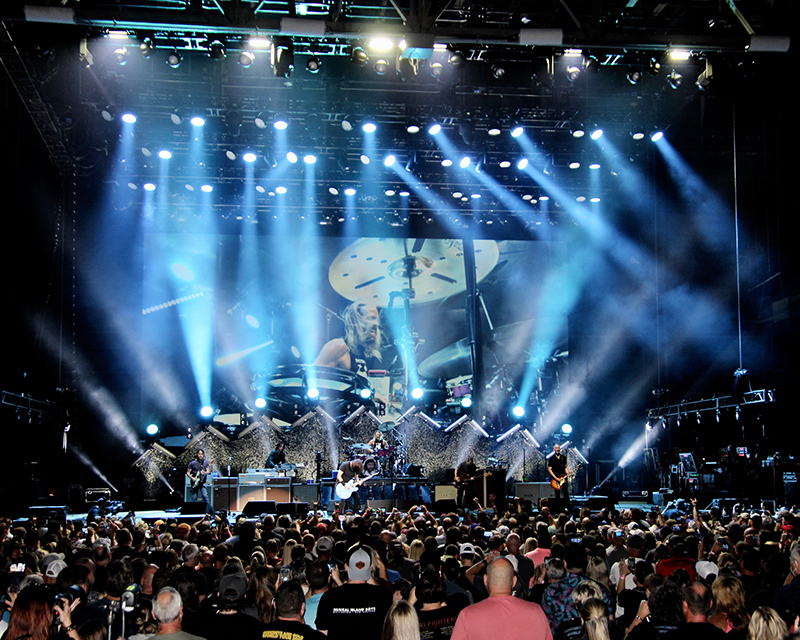
Video Use was Key
What largely replaced all those bells and whistles was images and manipulation of those images on the video wall. “It was important, as it gave us a bit of latitude in using a more basic lighting rig without automation/lasers etc.,” Hadley explains. “The content was developed with and produced by Kerstin Hovland and Emery Martin of Electronic Countermeasures and really worked well, especially in the hands of our video team Josh Adams and Hayden Katz.” And some nifty tricks spiffed up what was completely I-Mag content. There were five camera operators but 14 cameras with nine PTZs (Pan Tilt Zoom) driven by Katz. Content captured was filtered and treated with effects.
The practical effects boxes were originally designed to transport the onstage action to a completely different environment while slicing, dicing and modifying the image with optical trickery saturated with a level of naturalism. “We did the first version for Beck’s Night Running tour [with Cage the Elephant] back in 2019, when Beck asked to be able to be transported into an infinity room while on stage,” says Emery Martin of Electronic Countermeasures. For the Foo Fighters, Hadley asked them to create the next iteration of that. “We prototyped a number of looks, but settled on four.” One especially haunting one was Accute, a sharp mirror effect that uses two pieces of mirror, the natural gaps at the joints, and the glossy nature of the small field monitors to display incoming video signals.
“Each box captures the ricocheting light with Blackmagic Design Micro Cinema cameras paired with various micro four-thirds prime lenses,” Martin says. “All of this sits in a standard 4RU server chassis, runs off an ATX power supply, takes SDI in and spits SDI out, sits in a rack, and rolls on and off a truck. Every slight smudge, spec of dust, aberration, and chance reflection and refraction grounds the images in space. It isn’t just a computer chugging away, this is real, and you are experiencing this in the now.”
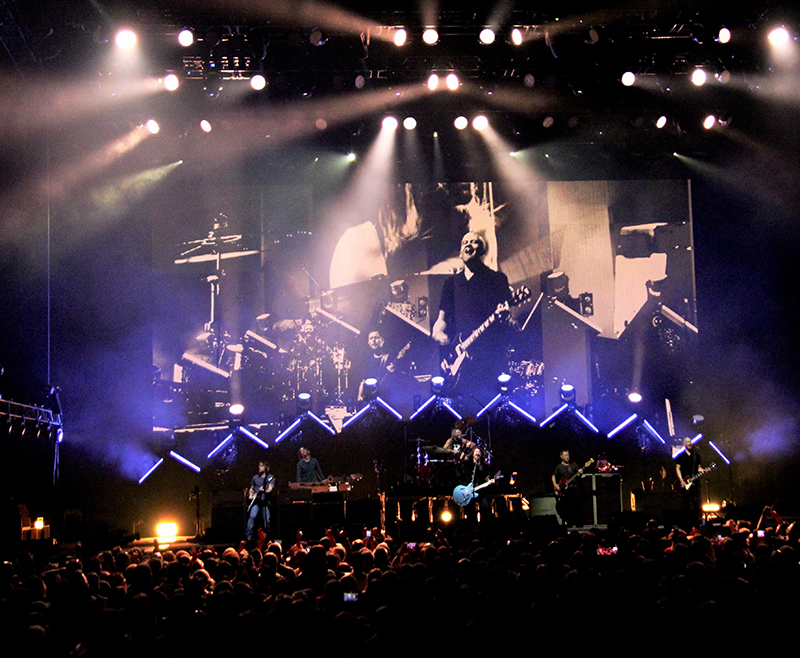
Mixing and Matching the Images
Adams is a Parnelli Award-winning video director, winning it at the last show held in January of 2019 (though he never made it to the stage — he had an attack of appendicitis and was in the hospital. Hadley took to the stage to accept it for him). The Milwaukee-based director has a strong pedigree: Christine Strand, a pioneer in live video direction who first followed Pete Townshend around the stage with a camera in 1982 before moving into directing, is his aunt. Adams hung out with her hauling cables and went to University of Wisconsin Oshkosh for “film school” [his air quotes]. Twenty-five years ago, he went out on his first major tour with Tina Turner. He has worked with the Beastie Boys, Barenaked Ladies and festivals like Lollapalooza, Coachella, and his hometown’s Summerfest festival. He’s been with the Foo Fighters since 2011. In 1999, he founded Mindpool Live, a video production company.
“I create live feed, and Hayden [Katz] is on the disguise server stylizing the content from live effects from different cameras and pre-produced content.” he says “You can see people having a great time and you look to capitalize on those moments. Dan [Hadley] does a great job leading the team down that road, and my vision is to always try to make sure to share the energy of the band. With some bands you have to create something that doesn’t exist [energy-wise], but that is not the case with these guys,” he laughs. Adams works with a Ross Carbonite Ultra taking in all the cameras and brings those in and out all on the fly. An especially nice touch is a movable camera on a track attached to the drum riser stage right; it was certainly put to good use capturing drummer Taylor Hawkins’ feverish playing.
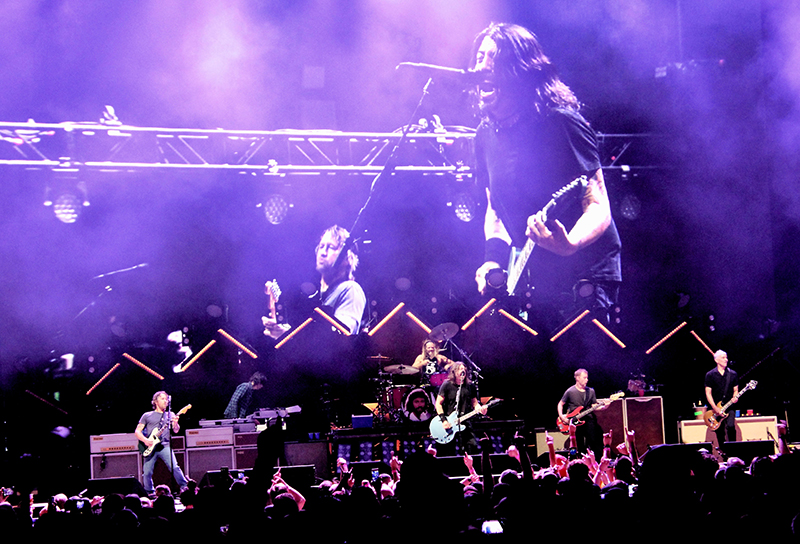
“PRG does a great job supporting us, and have always been great partners over the years,” Adams says. “They take care of almost all the video systems, though through Mindpool, I bring a few of my own tools to the table.” As the video director, he creates a line cut and talks to all the five camera operators while controlling eight POV and robotic cameras. “That gives me a total of 13 cameras that I am using to create a program line cut on a nightly basis,” he says. Most of the time the upstage center wall is stylized to match the look of each song. “So while you see the line cut much of the time on the upstage center wall, it is being treated with an effect or graphic overlay through one of the physical effects boxes or a Notch effect in the disguise server. The side screens are primarily clean I-Mag, or I-Mag with LUT applied. I’m also creating independent live feeds for the occasional live stream or broadcast feed.”
Adams also mentions the limited budget and footprint of this tour. “Our engineer Dan Albert and I spent the last 20 months in a Milwaukee studio bubble working to create a system that would implement cleanly and easily deploy on a daily basis,” Adams says. “With that, we’ve really gone all in with Ross at the center of our infrastructure,” with Carbonite switching, Ultrix routing and openGear Modular Infrastructure for modular signal processing. “A great feature of having all of this centralized on the Ross platform is that we are able to access all of our switching, routing, and signal QC on our network via the Ross Dashboard. We’ve got confidence and control of all our production tools at our fingertips from any workstation.
Albert has done some great things with our network and it has not only helped with video diagnostics and operation, but it has allowed us to streamline audio and communications workflow with Dante and HelixNet.” So not only can the switcher handle 24 inputs, but the video team “can record 16 channels of video with our four Ki Pro Ultra + recorders and 64 channels of audio on the PIX 270i.”
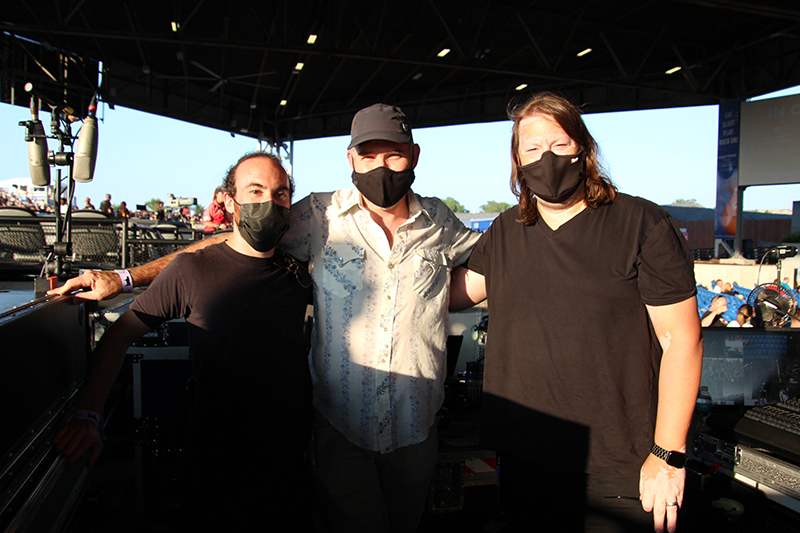
Dancing on the Board
Hayden Katz was born in Manhattan, raised in New Jersey, and then “returned to New York as quickly as I could.” Like many in this biz, he did high school theater tech; like probably no other single person in this biz, he went on to get a Bachelors in Fine Arts in Modern Dance, and he makes the case that he uses that every day at his current gig as video content director. Through college he worked summers as a stagehand, earned his way into the IATSE labor union, and bounced into being a touring lighting tech working for U2, Elton John, Cher, and finishing up that stretch with Bon Jovi outing. A stint at Control Freak Systems got him versed in media servers. He’s been with the Foo Fighters since 2017, starting as a video system tech and became content director in 2019.
“Being a roadie is the closest thing to dancing,” he says. “You create these questions, and then you attempt to answer them, and it’s all improvisation. With every show you load in and load out of, you hone those ‘answers’ every day and get better.” The abstract visual nature of this show is especially fitting for what Katz studied in school. “How we layer things, how we create relationships with what we’re seeing with the music’s rhythm, harmony, and counterpoint is all movement.” Keeping him on his proverbial toes is that there is no timecode, no click track — they get a set list, but the band doesn’t always stick to it.
“This is way more video intensive than any other shows, with Electric Countermeasures creating brilliant camera overlays,” Katz says. The PTZ cameras are pointed at abstract things like the drum pedal, which is overlaid with the stage pedal board. It’s a great-looking show because it’s all live with almost no prebaked content, and that really suits the band, especially at this moment in time.” He also confirms the being-ready-for-anything atmosphere. One night, John Travolta was in the crowd, and bass player Nate Mendel started the opening riff to a Grease song, and then Dave Grohl jumped in, singing “I got chills, they’re multiplying…” The team must pivot with visuals that match one-of-a-kind moments like that.
“Watching Dan operate the show is really something,” Katz adds. “He is an amazing master of angles and creating depth. He’s a brilliant designer, and getting to watch him operate — someone who like me is also hitting buttons constantly — I don’t know how he does it.”
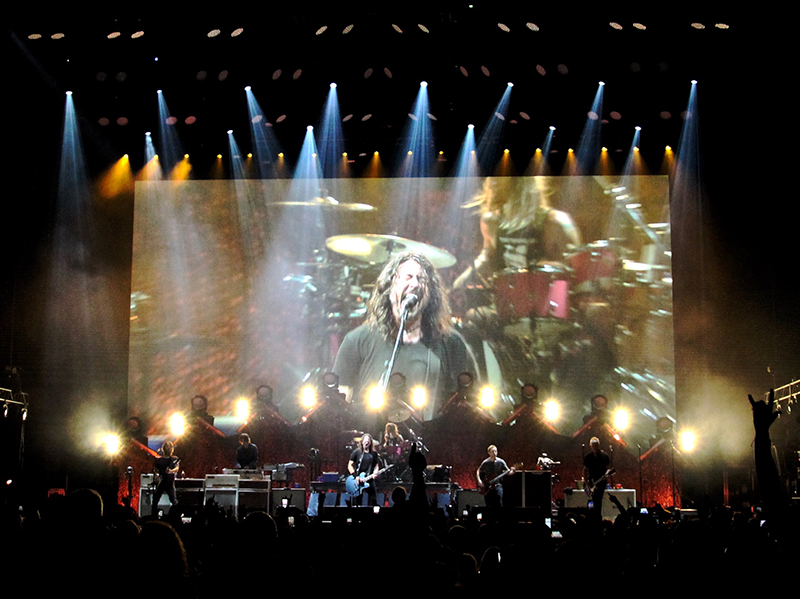
Foo Fighters 2021 Tour
Crew
- Production Manager: John Lafferty
- Production Coordinator: Fiona Scott
- Tour Manager Assistant: Katie Shape
- Production Designer/Lighting Designer: Dan Hadley
- Video Director: Josh Adams
- Video Content Director: Hayden Katz
- Video Crew Chief: Cam Dixon
- Video Engineer: Dan Albert
- Video Content: Electronic Countermeasures/Kerstin Hovland, Emery Martin
- Stage Manager: Greg Bogart
- Covid Compliance: Sacha Bambadji
- Head Rigger: Jim Allison
- Lighting Crew Chief: Jerry “Hodgie” Vierna
- Lighting Crew: Doug Eder, Patrick Sieg, Robert Simoneaux, Matthew “Skinny” Leroux
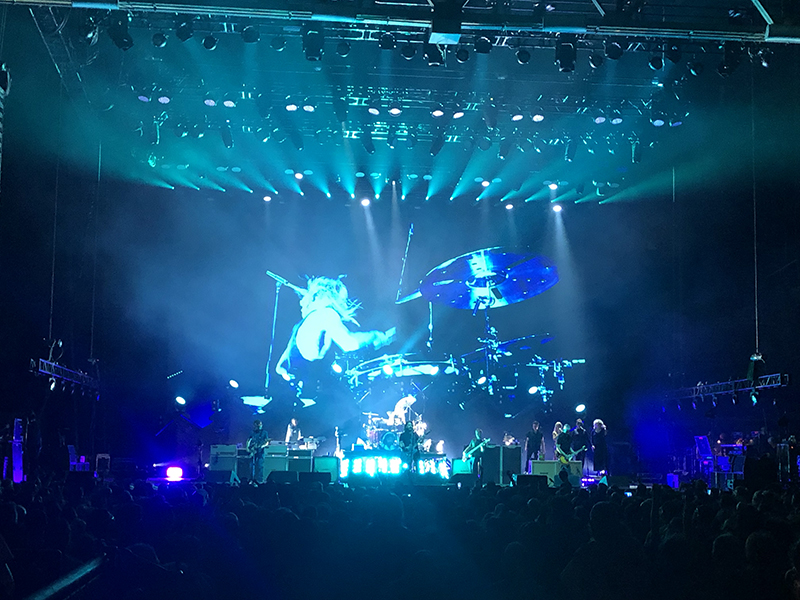
Gear
Lighting:
- 2 grandMA2 consoles
- 28 Robe MegaPointes
- 17 Robe BMFL Spots
- 3 Robe BMFL Blades
- 61 Martin MAC Quantum Washes
- 19 Martin MAC Aura XB’s
- 9 PRG Toblerones
- 6 PRG GC Best Boys
- 18 GLP X4 Bar 20’s
- 17 GLP JDC1 strobes
- 12 Chauvet Strike 1 blinders
- 10 Elation Cuepix WW2’s
- 2 MDG theONE hazers
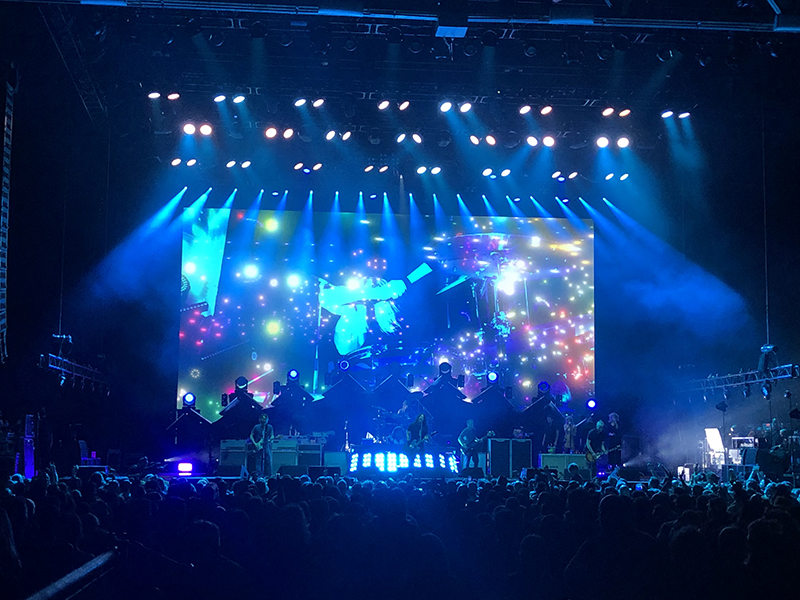
Video:
- 5 Sony HDC-3500 cameras
- 10 Sony BRC-X400 pan-tilt-zoom cameras
- 6 AJA RovoCams
- 2 Sony RM-IP500 Controllers
- 1 Ross Carbonite Ultra Switcher w/2ME control surface
- 1 36×36 Ross Ultrix Router
- 2 Ross oGx openGear chassis w/DA, embedders fiber conversion, etc.
- 1 Ross SRG-2200 unit
- 1 Focusrite RedNet A8R
- 1 Clearcom HelixNet system
- 4 AJA KiPro Ultra Plus recorders
- 1 Video Devices PIX 270i recorder
- 1 Cisco network equipment setup


